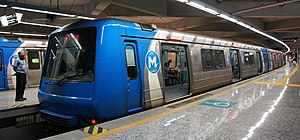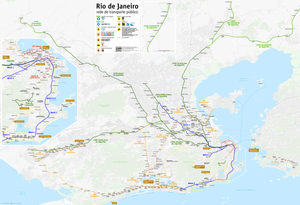Rio de Janeiro Metro

|
|||
| Overview | |||
|---|---|---|---|
| Native name | MetrôRio | ||
| Owner | Rio Trilhos (State of Rio de Janeiro) | ||
| Locale | Rio de Janeiro, RJ, Brazil | ||
| Transit type | Rapid transit | ||
| Number of lines | 3 (Lines 1, 2 & 4) | ||
| Number of stations | 41 | ||
| Daily ridership | 625 205 (2014) | ||
| Annual ridership | 228.2 million (2014) | ||
| Website | Metrô Rio | ||
| Operation | |||
| Began operation | March 5, 1979 | ||
| Operator(s) | Concessão Metroviária do Rio de Janeiro S.A. (Invepar) | ||
| Technical | |||
| System length | 58 km (36 mi) | ||
| Track gauge | 1,600 mm (5 ft 3 in) | ||
|
|||
The Rio de Janeiro Metro (Portuguese: MetrôRio IPA: [meˌtɾo ˈʁi.u], commonly referred to as just the Metrô [Meˈtɾo]) is a mass-transit underground railway network that serves the city of Rio de Janeiro, Brazil. The Metrô was inaugurated on March 5, 1979 and consisted of five stations operating on a single line. The system currently covers a total of 58 kilometres (36 mi), serving 41 stations, divided into three lines: Line 1 (16 kilometres (9.9 mi)); Line 2 (30.2 kilometres (18.8 mi)), which together travel over a shared stretch of line that covers 10 stations of an approximate distance of 5 kilometers; and Line 4 (16 kilometres (9.9 mi)). Metrô Rio has the second highest passenger volume of the metro systems in Brazil, after the São Paulo Metro.
Line 1 (orange line) serves downtown Rio, tourist areas in the South Zone, and several neighbourhoods in the North Zone. It is a semicircular line, and is fully underground. It runs from Uruguai Station to Ipanema/General Osório Station. Line 2 (green line) serves working-class residential neighborhoods extending toward the north. It is a northwest-to-southeast line, and almost completely above-ground (mostly at grade and partly elevated). This line started as a light rail, but due to increasing numbers of commuters, it gradually changed to rapid transit or metro. Because of its origin as light rail, it is at grade except for Estácio Station (the former connection station between lines 1 and 2), which is underground and Cidade Nova Station, which is elevated, and Line 4 (yellow line), connecting Barra da Tijuca/Jardim Oceânico Station in the West Zone to Ipanema/General Osório Station on Line 1.
...
Wikipedia

